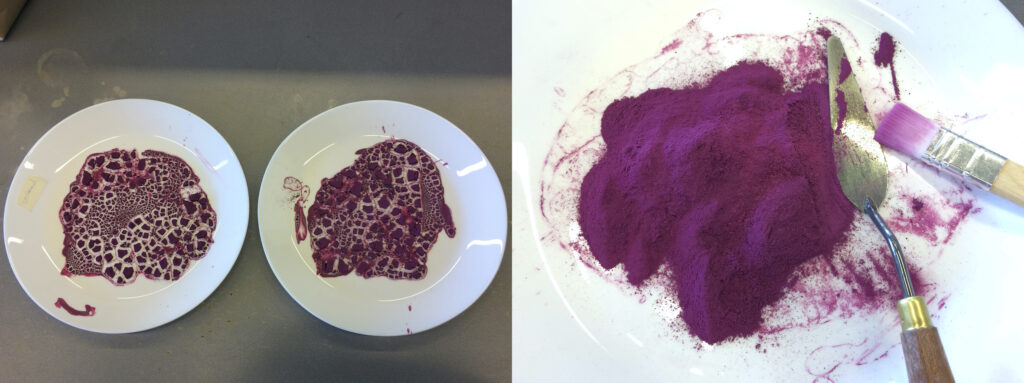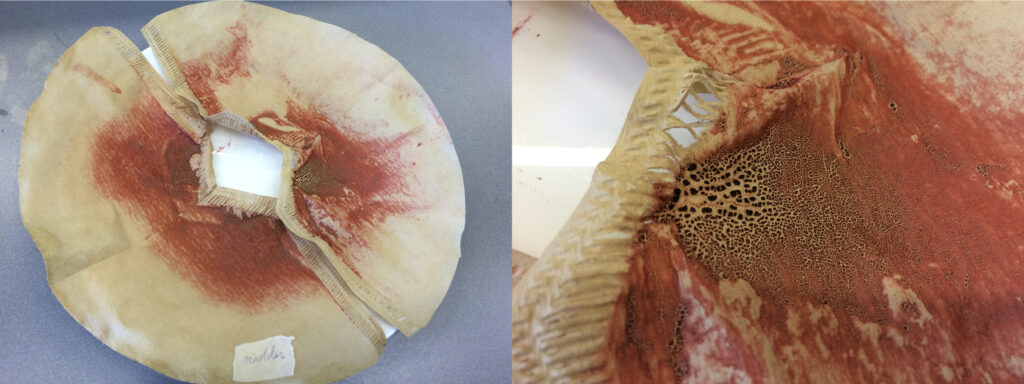*This blog post is part of the series Making Colors. The historical remaking research of my project is supported by the grant from the Oak Spring Garden Foundation.
The first lesson I learned when I began the historical remaking research of my project was embracing the mistakes, errors, and failures in the process and result. They have been an expected and integral part of the making and remaking process in the past year. Despite knowing so, it was frustrating nonetheless when an experiment did not lead to a successful pigment, wash, or painting. However, I find myself not only welcoming failed experiments, but often valuing them more than successful ones as I progress over time.
Defining success in artistic production
What do failure and success mean within the context of artistic production, then? Of course, the definitions vary greatly depending on a maker’s goal and intention. Broadly speaking, however, one can objectively (and sometimes subjectively) assess and determine if an artwork is successful from its use of formal elements and level of technical execution, as well as its effectiveness in communicating visual information and/or emotion. On the material end, a “successful” pigment or other kind of art supply can generally refer to functioning and high quality products, usually with a greater level of permanence.
When conducting historical reconstruction or remaking experiments, I often apply similar criteria to assess the results. For example, I successfully made a deep and saturated red lake pigment with dye extracted from cochineal insects (Fig. 1). In the same week, my experiment with madder red (Fig. 2) failed because the process hardly yielded any pigment; the quantity was too small for the color to be useful for painting, and the recipe is supposed to produce a proper amount of pigment.
Fig. 1. Result of the cochineal lake pigment.
Fig. 2. Result of the madder lake pigment.
Making a pastill
My greatest failure among all the experiments is perhaps the reconstruction of the pastill to extract ultramarine pigment from lapis lazuli stones. There are several historical recipes for this process, including one from Cennino Cenini’s Il Libro dell’ Arte (c. 1400).[1] The art supplier Master Pigments tested this recipe with a successful result. This demonstration became useful for me to expect what a functioning pastill should do and have a concrete point of comparison.
For my own experiment, I followed the recipe from the Miniatura; or, The art of limning (1627/1628, 1648).[2] This book is one of the major sources for understanding the materials and techniques of early modern watercolor, and the time period is contemporaneous to the botanical watercolors of my investigation. Norgate’s recipe calls for a few more ingredients and has rather different descriptions for the steps, but the overall process is comparable to the one of Cenini’s recipe.
The experiment took me two days to complete (Fig. 3/Vid. 1). The first day involves solely breaking the stone. I first crushed a piece of lapis lazuli into chunks with a hammer, and continued breaking them into small pieces with a mortar and pestle. There are ways, both described in Norgate and by modern practitioners, to weaken the stone by heating it, but I could not do so because of the safety measures with which I was working.[3] With brute force, I was only able to get 22g of crushed stones out of the big piece, weighted 244g. I took the coarse powder to the granite slate and ground it with water under the glass muller for about an hour, and left it to dry overnight.
On the next day, I collected the ground powder. Following the recipe, I melted 6 parts of beeswax before adding—in this order—4 parts of colophony, 2 parts of mastic, 3 parts of linseed oil, and 5 parts of turpentine. Two ingredients, Rosen and Razo de pino grasso were eliminated from this experiment because they were not available to me. Finally, I added the lapis lazuli powder when the mixture was fully melted. The result of the pastill was far from ideal. The dough was excessively sticky; it never fully dried, and thus not possible to knead and extract the pigment. Two days of work and the cost of the materials gone, and I still had no ultramarine blue for painting.
Fig. 3/Vid. 1. Photo sequence of the experiment process (or link to Youtube).
Shifting perspectives
Looking back, it became clear that the experiment was destined to fail. The stone I purchased has a high content of impurity; the ground powder was nowhere fine enough; there were missing ingredients in the pastill; the list goes on. Learning from this failure, I can expect that a future attempt might have a higher possibility of success after identifying and correcting the problems. It should be pointed out, however, that this evaluation of failure and success comes from the perspective of a supposed practitioner, with the eventual goal of the experiment a usable (if not quality) ultramarine blue pigment.
When reflecting on the experiment through the lens of a researcher, the value of this failed attempt became more prominent. It connected many dots that were previously implicit from reading historical text and secondary literature. It raised many questions, several of which align with existing discussions by researchers of early modern recipes. It sparked new possibilities, either hypotheses or curiosity to be tested. From this perspective, the pastill experiment was among the most “successful” in engaging with different kinds of thinking. Historical reconstruction and remaking is particularly useful in the sense that multiple perspectives can be explored and experienced simultaneously. Consequently, the “data” gathered throughout this process needs to be carefully interpreted to avoid conflation of these perspectives, but that should be done for any type of source.
Looking to fail
Once I have trained myself to better distinguish these perspectives, the level of success in the end result became less relevant. Successful results of quality pigments are welcomed for further painting tests, while failed experiments provide other useful information. Going one step further, I started setting myself up to fail by not always following the “proper” steps as instructed. The curiosity to see what would happen gradually outweighed the yearning for successful end products, but that is the subject for the next post to come.
[1] Cennino Cennini, The Craftsman’s Handbook. The Italian “Il Libro dell’ Arte,” translated by Daniel V. Thompson Jr. (New York: Dover Publications, Inc., 1933), 36–39. Transcribed text can be found here: http://www.noteaccess.com/Texts/Cennini/2a.htm.
[2] Edward Norgate, Miniatura; or, The art of limning, edited and collated by Martin Hardie (Oxford: Clarendon Press, 1919), 68–69. Jeffrey Muller and Jim Murrell dated the earlier version of the manuscript in 1627/1628 and a later one in 1648, see book review by John Peacock, https://hnanews.org/hnar/reviews/miniatura-art-limning/.
[3] Norgate, 67.


1 thought on “Making Colors (7): Failure and Success in Historical Remaking”